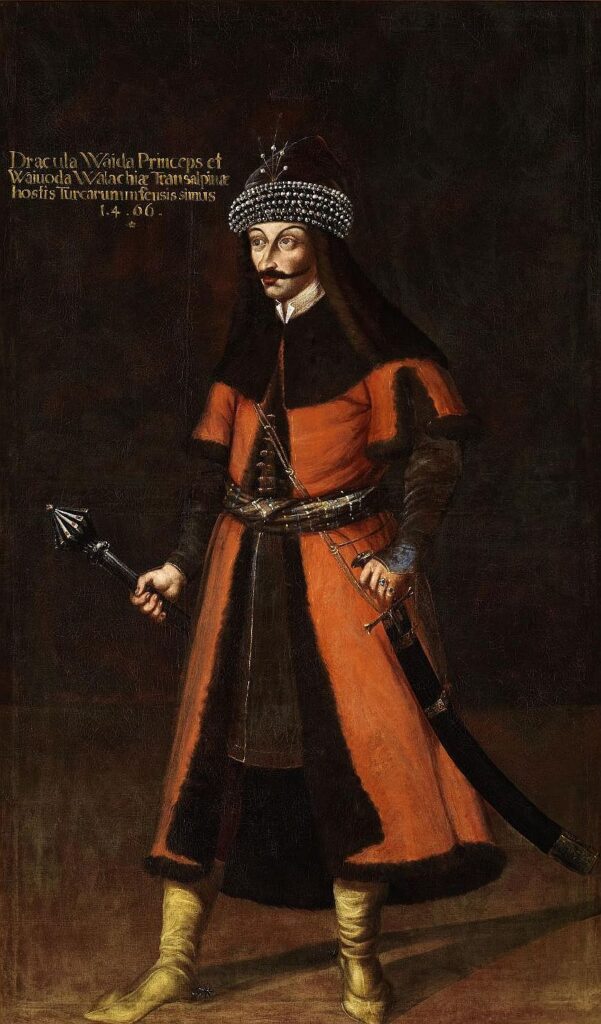Poenari Castle is known as the home of Vlad the Impaler during the early 13th century. It sits on the Arges River in the South Carpathian Mountain range north of the Pericarpathian Fault line (PcF) of the Moesian Platform (Mostiştea basin). While its exact origins are unknown, the earliest records recount a story of Vlad the Impaler forcing the residents of the local village to construct the castle as punishment for betraying his brother.
The castle was part of the defensive ring around the kingdom of Wallachian built during the period of invasion from the Ottoman Empire. Other structures constructed at this time were the Fortress of Severin and the Bucharest Fortress along the Danube River.
Villages and cities in the Moesian Platform attest to this with evidence of fortified walls and buildings with the intent to defend against raiding Ottoman parties that would source from the Danube River in the south.
Because of the few sources available, the use for Poenari Castle is not fully understood. One source mentions the stronghold as the treasury; another talks about a holding for political prisoners, or a refuge for nobles fleeing the Ottomans. What is documented are records of important nobles and kings, including Vlad the Impaler who called this castle their home.
Eventually, the Ottoman’s were too powerful, and Wallachia succumbed to their influence and became a tributary state to the Sultanate.
Despite the strategic indomitable position, surrounded by the Arges river on three sides and a mountainous chokepoint on the fourth, its later collapse and abandonment in the 15th century was not from conquest, but due to the decreasing trade and traffic into the surrounding area.
My theory is that with the subsequent end to battle, trade could resume for the Wallachians on the Danube river, and transportation along the Transfăgărșan through the Carpathians in the north may have decreased significantly, reducing the amount of wealth and goods in the area. The last known records of Poenari end around this time, and the structure remained abandoned for nearly 500 years.

While Bran Castle is notably tied to the Dracula myth, the truth of the vampiric origins lies within the walls of Poenari Castle. Thanks to 13th century politics between the Ottomans and Wallachians, Vlad the Impaler–or Vlad Dracula as his real name goes—was turned into a horror story by the Turks in order to turn his people against him.
While his nickname Tepes (or “the Impaler”) accurately described his merciless punishments of princes and nobles who did not share his beliefs, the Ottomans took an extra step to describe him as a drinker of blood, stalking the night in search of his next victim. Tall tales took over in the following centuries, culminating with Bram Stoker’s literary classic that solidified Dracula as one of the greatest folk stories in Western Culture.
There is no evidence that Vlad ever lived at Bran Castle, but rather resided in Poenari Castle as he waged a defensive war against the invading Ottomans. For Romanians, he was considered a hero, eliminating his enemies.
FRANCIS E. GRIGGS, JR. – Civil Engineering Practice | SPRING/SUMMER 2007
The castle was built with ancient Roman and Byzantium techniques; a stone foundation with brick and emplecton used in the walls and towers. This is similar in style to other castles in the Transylvania and Balken region as well, particularly Hațeg.
Due to its neglect for centuries, much of the structural information can only be found through excavations and relics buried beneath the rubble and dirt. Discoveries show evidence for the use of heavy artillery, perhaps to defend its narrow and laborious single-path to the castle, or for laying siege to warring ships in the Arges River below.
Cantacuzino, , Gheorghe I. “Cetatea Poenari.” Studii Și Cercetări de Istorie Veche Și Arheologie (SCIVA), vol. 22, no. 2, 1971, pp. 263–290: https://biblioteca-digitala.ro/?articol=119744-cetatea-poenari–studii-si-cercetari-de-istorie-veche-si-arheologie-sciva–2-22-1971
Staking out Dracula’s castle in Romania (CNN)
Rolandia.eu: https://rolandia.eu/en/blog/history-of-romania/vlad-the-impaler-the-ruthless-ruler-of-wallachia
(+)
https://rolandia.eu/en/blog/places/poenari-castle-vlad-the-impaler-s-impenetrable-fortress
Romaniatourism.com: https://romaniatourism.com/press-dracula-travel-journal-in-the-footsteps-of-dracula.html
Stanciu, I.; Ioane, D. Geomorphological and Neotectonic Structures Studied in the Southern Part of the Moesian Platform in Romania. Geographies 2023, 3, 743-762. https://doi.org/10.3390/geographies3040040
Molon Labe